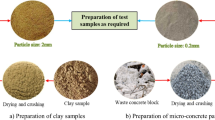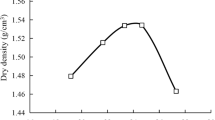Abstract
Effects of clay content on soil desiccation cracking characteristics were explored by testing three soils, i.e., a natural low-plasticity loess, the loess with clay removal, and the loess with 25% clay addition (denoted as soil-A, soil-B, and soil-C). The shrinkage and desiccation cracking of the three soils were interpreted with the assistance of mercury intrusion porosimetry (MIP) and scanning electron microscope (SEM). Results show that clay content significantly influences soil shrinkage and desiccation cracking patterns. Different from soil-A, soil-B shows a structural shrinkage stage at the beginning of drying and soil-C has a non-zero shrinkage stage at the end of drying. These findings are because clay removal and addition produce many large-sized macro-pores (i.e., 21.34 μm) and small-sized micro-pores (i.e., 0.04 μm), respectively, as evidenced by SEM and MIP results. On the other hand, soil-A has single and “Y shape” cracks, while only the former crack is observed for soil-C. The lack of “Y shape” crack in soil-C is attributed to its homogenous skeleton and uniform pore size distribution because of clay addition. The desiccation cracking was absent in soil-B, mainly due to its small shrinkage capacity and homogeneous structure induced by clay removal. In addition, soil shrinkage and desiccation cracking occurred due to water evaporation in macro-pores.













Similar content being viewed by others
Data availability
All data, models, and code generated or used during the study are available from the corresponding author upon request.
References
Akbarimehr D, Eslami A, Aflaki E, Hajitaheriha MM (2021) Investigating the effect of waste rubber in granular form on strength behavior of Tehran clay. Arabian J Geosci 14:1831
ASTM D422–63 (2007) Standard test method for particle-size analysis of soils. West Conshohocken, PA: ASTM International
ASTM D4943–08 (2008) Standard test method for shrinkage factors of soils by the wax method. West Conshohocken, PA: ASTM International
Barani OR, Barfar P (2021) Effect of xanthan gum biopolymer on fracture properties of clay. J Mater Civ Eng ASCE 33(1):402–426
Birle E, Heyer D, Vogt N (2008) Influence of the initial water content and dry density on the soil–water retention curve and the shrinkage behavior of a compacted clay. Acta Geotech 3(3):191–200
Boivin P, Garnier P, Tessier D (2004) Relationship between clay content, clay type, and shrinkage properties of soil samples. Soil Sci Soc Am J 68(4):1145–1153
Chen P, Lu N (2018) Generalized equation for soil shrinkage curve. J Geotech Geoenviron Eng ASCE 144(8):04018046
Cheng Q, Tang CS, Chen ZG, El-Maarry MR, Zeng H, Shi B (2020) Tensile behavior of clayey soils during desiccation cracking process. Eng Geol 279:105909
Costa S, Kodikara JK, Shannon B (2013) Salient factors controlling desiccation cracking of clay in laboratory experiments. Géotechnique 63(1):18–29
Delage P, Audiguier M, Cui YJ, Howat MD (1996) Microstructure of a compacted silt. Can Geotech J 33(1):150–158
Dong Y, Lu N, Fox PJ (2020) Drying-induced consolidation in soil. J Geotech Geoenviron Eng ASCE 146(9):04020092
Eslami A, Akbarimehr D (2021) Failure analysis of clay soil-rubber waste mixture as a sustainable construction material. Constr Build Mater 310:125274
Fredlund DG, Rahardjo H (1993) Soil mechanics for unsaturated soils. John Wiley & Sons Inc
Ghazizade MJ, Safari E (2017) Analysis of desiccation crack depth in three compacted clay liners exposed to annual cycle of atmospheric conditions with and without a geotextile cover. J Geotech Geoenviron Eng ASCE 143(3):06016024
Haines WB (1923) The volume changes associated with variations of water content in soil. J Agric Sci 13:296–310
Jahangard H, Hosseini SMMM, Ebadi T, Akbarimehr D (2022) Effect of gas oil contamination on dynamic geotechnical properties of clay-sand mixtures. Arabian J Geosci 15(3):278
Jamalinia E, Vardon PJ, Steele-Dunne SC (2020) The impact of evaporation induced cracks and precipitation on temporal slope stability. Comput Geotech 122:103506
Li JH, Li L, Chen R, Li DQ (2016) Cracking and vertical preferential flow through landfill clay liners. Eng Geol 206:33–41
Liu XF, Buzzi O, Yuan SY, Mendes J, Fityus S (2016) Multi-scale characterization of retention and shrinkage behaviour of four Australian clayey soils. Can Geotech J 53(5):854–870
Mitchell JK, Soga K (2005) Fundamentals of soil behavior. John Wiley & Sons, New York
Mu QY, Dong H, Liao HJ, Zhou C, Li SB, Zhang JW (2022) Effects of in situ wetting-drying cycles on the mechanical behaviour of an intact loess. Can Geotech J 59(7):1281–1284
Mu QY, Zhan LT, Lin CP, Chen YM (2020a) Non-invasive time domain reflectometry probe for transient measurement of water retention curves in structured soils. Eng Geol 264:105335
Mu QY, Zhou C, Ng CWW (2020b) Compression and wetting induced volumetric behavior of loess: macro- and micro-investigations. Transp Geotech 23:100345
Ng CWW, Sadeghi H, Hossen SB, Chiu CF, Alonso EE, Baghbanrezvan S (2016) Water retention and volumetric characteristics of intact and re-compacted loess. Can Geotech J 53(8):1258–1269
Ng CWW, Zhou C, Chiu CF (2020) Constitutive modelling of state-dependent behaviour of unsaturated soils: an overview. Acta Geotech 15(10):2705–2725
Peng XH, Horn R (2013) Identifying six types of soil shrinkage curves from a large set of experimental data. Soil Sci Soc Am J 77(2):372–381
Peron H, Hueckel T, Laloui L, Hu LB (2009) Fundamentals of desiccation cracking of fine-grained soils: experimental characterisation and mechanisms identification. Can Geotech J 46(10):1177–1201
Romero E, Della Vecchia G, Jommi C (2011) An insight into the water retention properties of compacted clayey soils. Géotechnique 61(4):313–328
Shin H, Santamarina JC (2011) Desiccation cracks in saturated fine-grained soils: particle-level phenomena and effective-stress analysis. Géotechnique 61(11):961–972
Sides G, Barden L (1971) The microstructure of dispersed and flocculated samples of kaolinite, illite, and montmorillonite. Can Geotech J 8(3):391–399
Soltani A, Taheri A, Deng A, O’Kelly BC (2022) Stabilization of a highly expansive soil using waste-tire-derived aggregates and lime treatment. Case Stud Constr Mater 16:e01133
Sridharan A, Prakash K (1998) Mechanism controlling the shrinkage limit of soils. Geotech Test J 21(3):240–250
Tan Y, Zhang HY, Wang Y (2020) Evaporation and shrinkage processes of compacted bentonite-sand mixtures. Soils Found 60(2):505–519
Tang CS, Shi B, Liu C, Zhao LZ, Wang BJ (2008) Influencing factors of geometrical structure of surface shrinkage cracks in clayey soils. Eng Geol 101(3–4):204–217
Tay YY, Stewart DI, Cousens TW (2001) Shrinkage and desiccation cracking in bentonite–sand landfill liners. Eng Geol 60(1–4):263–274
Tuller M, Or D (2005) Water films and scaling of soil characteristic curves at low water contents. Water Resour Res 41(9):W09403
Wei X, Hattab M, Bompard P, Fleureau JM (2016) Highlighting some mechanisms of crack formation and propagation in clays on drying path. Géotechnique 66(4):287–300
Wilson GW, Fredlund DG, Barbour SL (1994) Coupled soil-atmosphere modelling for soil evaporation. Can Geotech J 31(2):151–161
Yesiller N, Miller CJ, Inci G, Yaldo K (2000) Desiccation and cracking behavior of three compacted landfill liner soils. Eng Geol 57(1–2):105–121
Zhang GP, Germaine JT, Martin RT, Whittle AJ (2003) A simple sample-mounting method for random powder X-ray diffraction. Clays Clay Miner 51(2):218–225
Zhang JM, Luo Y, Zhou Z, Chong L, Victor C, Zhang YF (2021) Effects of preferential flow induced by desiccation cracks on slope stability. Eng Geol 288:106164
Zhuang JQ, Peng JB (2014) A coupled slope cutting-a prolonged rainfall-induced loess landslide: a 17 October 2011 case study. Bull Eng Geol Env 73(4):997–1011
Acknowledgements
This work was supported by the National Science Foundation of China (52279109), the opening fund of MOE Key laboratory of Soft Soils and Geoenvironmental Engineering (2020P02), and the opening fund of Technology Innovation Center for Land Engineering and Human Settlements, Shaanxi Land Engineering Construction Group Co., Ltd. and Xi’an Jiaotong University (201912131-A4).
Author information
Authors and Affiliations
Corresponding author
Ethics declarations
Conflict of interest
The authors declare that they have no conflict of interests.
Rights and permissions
Springer Nature or its licensor (e.g. a society or other partner) holds exclusive rights to this article under a publishing agreement with the author(s) or other rightsholder(s); author self-archiving of the accepted manuscript version of this article is solely governed by the terms of such publishing agreement and applicable law.
About this article
Cite this article
Mu, Q., Meng, L., Shen, Y. et al. Effects of clay content on the desiccation cracking behavior of low-plasticity soils. Bull Eng Geol Environ 82, 317 (2023). https://doi.org/10.1007/s10064-023-03346-6
Received:
Accepted:
Published:
DOI: https://doi.org/10.1007/s10064-023-03346-6




